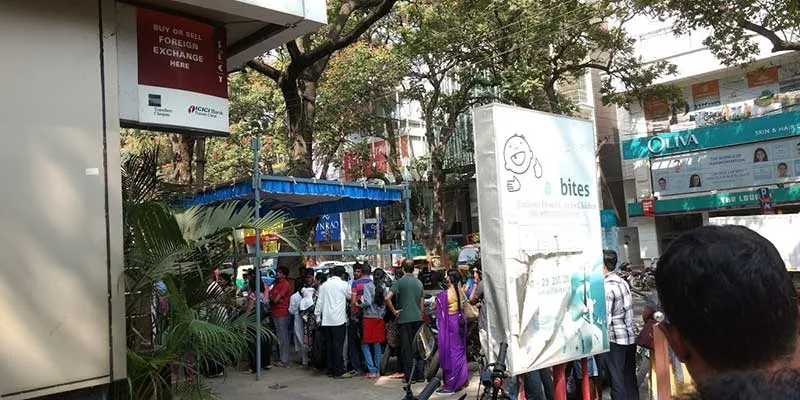Demonetisation: Burning the barn to kill the mice
It has been almost 45 days since Prime Minister Modi stole the thunder on our Facebook walls, diverting attention from a bitterly fought US Presidential election that we had obsessed over, a night before its results. Demonetisation is indeed one of the most audacious economic experiments in modern India’s history. However, as an economist writing this article, I will not go ahead and pitch my two cents over the numerical impact of this move on India’s growth numbers.
All models or scenario analyses that claim to predict the effects of demonetisation on the economy, frankly, are based on assumptions that are as good as our own personal experiences and biases. Instead of entering into studies like the metaphorical blind men trying to ascertain what an elephant looks like, let us cast our punditry aside. Let us begin by just asking a few questions about the extent to which the government and mainstream economists’ mantra of “short-term pain for long-term gain” is not simply a statement of faith.
Also read - How demonetisation has impacted the Indian SME

Zillions of pixels and no small amount of journalism have gone into dissecting the progress of demonetisation. So much so that some have either missed the woods for the trees, mistaking the ability of their immediate urban neighborhood to switch from cash to digital as an encompassing sample of “jugaad” in India, or have conflated a single policy issue into a verdict on the soundness of an otherwise reform-minded government. This is why a delayed response to the transformative step/self-manufactured crisis is still an opportune moment to see a chapter of history already having unfolded and to examine the new questions before us.
And like every investigation, let us begin with the question of motive. What motivated the demonetisation? The initial spin by the government was that it was a “surgical strike” against black money and untaxed income. In a lot of ways, the move was indeed a surgical strike, except for one thing - it is completely imprecise in its targets. It was truly an unanticipated punishment intended to discomfort hoarders of cash and discourage petty corruption. But public policy is a lot like war. A surgical strike is a tactical maneuver – it instills a momentary fear in the hearts of your enemies, but never wins you the war. Without doubt, demonetisation sent cash hoarders scurrying in panic, exchanging cash for gold. However, without the accompanying reinforcements of a strong Real Estate Regulation Act and a fully functional GST regime, this surgical strike seems a bit premature. So, while the last few months may have impeded the flow of corrupt money, struck at counterfeiting and hit at election finances, they will scarcely scratch the surface of India’s black economy in isolation. A better response than this “shock therapy” could have been a gradual closure of tax loopholes, improvement in tax information collection and incentivising digital payment systems. Instead, the government chose to change public economic behaviour through a firm shove, rather than by nudging them towards it.
Related read - How will the Rs 500 and Rs 1,000 note ban impact your business?
Another puzzling aspect in the initial days of the move was its secrecy, of keeping it classified even from its eventual implementers. Given the way the new rules are being made on the fly, and the crying shortage of new currency bills in the economy, it appears that the RBI, the government mint and even some senior ministers were kept in the dark. In that context, it does seem ironic that the government intends to go after tax evaders with the same set of bureaucrats that it was not ready to trust with classified information.
Demonetisation as a measure has had some success. It has massively impacted the circulation of counterfeit currency in the system (0.2 percent of GDP), which has been frequently used to finance left wing insurgency. It has also made vote buying through cash payments difficult in a busy election season. However, the positive side effects of a policy cannot be a justification for it’s more direct and adverse impact in the short-term. Indeed, both the above benefits could have also been attained by improving the intelligence on counterfeit activities and election law reform (for which the government has shown some belated enthusiasm).
Furthermore, there are still questions over whether even the deposition of close to Rs 12 trillion in Indian banks is likely to bring down corruption and tax avoidance. The government’s ability to track transactions through the banking system could still weaken once ATM withdrawal limits are lifted. It will be foolhardy to believe that depositors who make close to 90 percent of their daily transactions in cash, and who live in a country where the density of ATMs is one-fourth of the developing country average, will not begin to take out cash once withdrawal limits are lifted. Unless the government wishes to put us in a situation like Greece, Cyprus or Iceland, by putting an extended limit on cash withdrawals to prevent tax avoidance, things will most likely return to normal. Obviously, a more sustainable measure to incentivise the informal sector (not necessarily part of the black economy) to avoid illegal transactions would have been to promote digital transactions. Progress on this front has been dramatic in the last two years, with growth in cashless transactions doubling since demonetisation, but from levels that are too small to create a sufficient critical mass in a short time.

The demonetisation program is also a misnomer in a way. But it doesn’t cancel (demonetise) the high value currency as much as replace it. A gradual phase out of high value currency notes is a wise idea that has been carried out by many governments in Europe with success. In the latter half of the last decade, the European Central Bank cancelled the Euro 500 note (the so called Bin Laden bank note), because it served no practical payment purpose and was used for making payments for human and drug trafficking. On the other hand, we have replaced high value Rs 500 and Rs 1,000 notes with new Rs 500 and Rs 2,000 notes, with security features whose strength is the stuff of urban legend (read embedded micro chip). And as tax raids in parts of the country have shown, thanks to the new 2,000-rupee note, what could be previously stowed in a briefcase can now be packed in a tiffin box. All in all, the demonetisation experiment ends up being an elaborate bean-counting exercise for the government to estimate the level of cash in the informal economy.
You may also like - Jugaad in the time of demonetisation – this app helps you find ATMs with cash and shorter queues
To be sure, demonetisation as a move towards a cashless and data-rich payment system is obviously a sensible policy, but one whose time hasn’t come yet. Imagine the impact of demonetisation on an economy where 47 percent of the population doesn’t have access to bank accounts, over 90 percent of transactions are in cash and just 30 percent of the population, at best, have access to smartphones. In such a case, lack of credible alternatives is unlikely to formalise a greater share of business activity. In fact, the greater the persistence of a withdrawal freeze on cash and longer the time taken to bring the new notes into full circulation, the more serious the chances that a short-term pain to the economy will endure longer. And the advertised long-term gains will be too far into the future to be electorally marketable.
Lastly, the hubris and unpreparedness that preceded demonetisation have themselves become the biggest enablers behind its painful experience. In the absence of a coordinated strategy and scenario analysis, the Finance Ministry and RBI have made rules on the go. And perhaps to convince itself of the validity of its actions, the government itself has remained fairly optimistic about the economic impact of demonetisation, despite widespread evidence of a freeze in economic activity over the past seven weeks. Strangely, after having repeatedly insisted that the amnesty was running out for tax evaders, the government announced another income disclosure scheme on November 28. But wasn’t demonetisation supposed to be the final punishment for tax evaders?
Whatever its long-term beneficial effects, demonetisation will be remembered as a good example of how even the best ideas, when prematurely introduced and poorly coordinated, can impose a heavy collateral damage in a desire for rapid change. Squeezing the circulation of fake notes and making election financing difficult at the cost of economic growth and individual hardship is akin to burning the barn to kill the mice.
(Disclaimer: The views and opinions expressed in this article are those of the author and do not necessarily reflect the views of YourStory.)
By the same author - Is size destiny?







